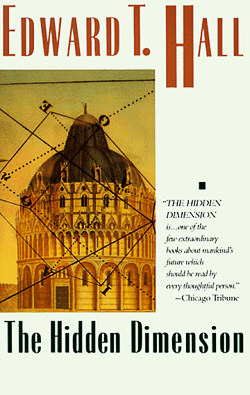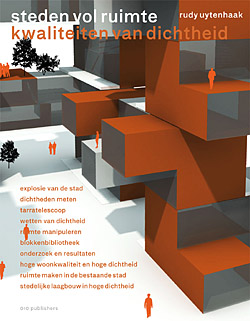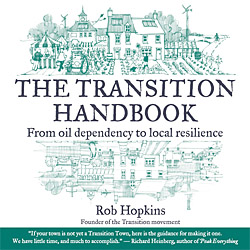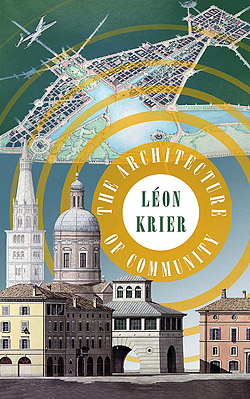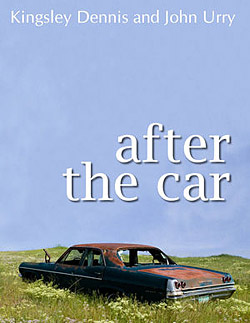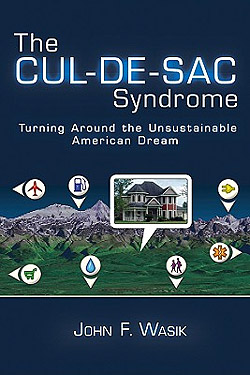
|
||
|
Issue 55 |
|
11 September 2009 |
|
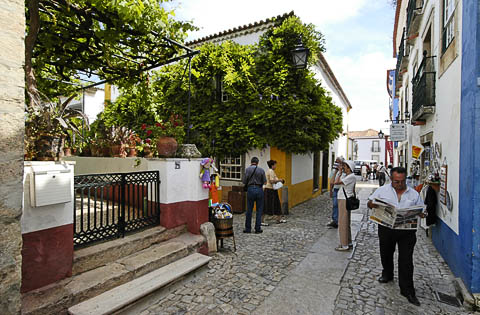 Obidos, Portugal ©2006 J.Crawford AnnouncementsThe BooksCarfree Design Manual is now widely available in Europe and North America. The major on-line retailers seem to have the book in stock. It is widely discounted from the US$45.00 cover price. Carfree Cities is still readily available in paperback.Photo ContestThis issue marks the end of the photo contest. Michael Huston and Mark Fleischmann contributed photographs to this issue. Thanks!World Carfree NetworkCarfree.com actively supports World Carfree Network [WCN]. They send the following news:Towards Carfree Cities IX to be hosted in YorkYork, a comparatively small city about midway between London and Edinburgh, will host Towards Carfree Cities IX between 28 June and 1 July 2010. This marks the first time the conference has been held in the UK. A committed and experienced group of organizers is on hand.Steering Committee Vacancies: Special call for EuropeansWCN is seeking new Steering Committee representatives to provide overall vision and strategic planning, in cooperation with the Prague office and the rest of the organization. Members serve for a two-year period. Nominations are being accepted until the end of the summer. Further information.Carfree BlogosphereWCN announces the "Carfree Blogosphere," a space to share information and discuss issues relevant to eliminating car dependency, exploring alternatives, and celebrating carfree life. Send your letters, articles, news, pictures, and videos to blog@worldcarfree.net. Visit the Carfree Blogosphere.Network Capacity Building SeminarA seminar will be combined with the annual general meeting in Prague, Czech Republic (5-8 November 2009). Workshops and seminars will be offered. The Annual General Meeting will be on 7 November.World Carfree DayIt's coming around again, and spokespersons are needed. WCN promotes and supports World Carfree Day, so we need spokespersons from around the world to help with promotion and information release. For more information please contact: info@worldcarfree.net. Share your ideas by adding your events to the global WCD Wiki and joining the celebrations on Facebook.Carbusters Magazine"First Steps in a Conversion Process" by J.H. Crawford was published in issue #39 of Carbusters, which has just been released. The article is reprinted in this issue of Carfree Times. Another three articles are expected to follow. The new issue also includes a special on China and its progress for a carfree future; a deeper look into carfree walks; an interview with Chris Carlsson on Critical Mass; and a celebration of carfree cartoons. Subscribe to Carbusters magazine. Follow Carbusters online.
|
News Bits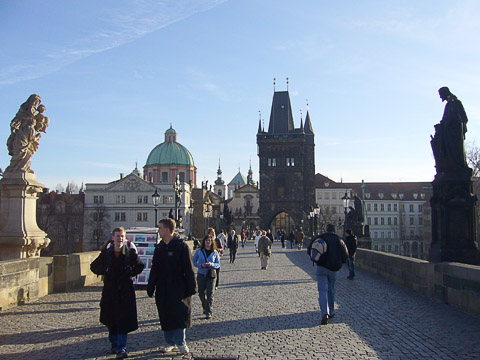 The Charles Bridge, facing the Old Town, Prague ©2006 Mark Fleischmann Let Them Cut EmissionsGeorge Monbiot recently published a column entitled "The rich can relax. We just need the poor world to cut emissions. By 125%." The UK government has been talking a good game on greenhouse emissions while planning for new roads, runways, and coal-burning power plants. It has bailed out auto makers and abandoned regulations for low-carbon housing. He thinks the contradictions cannot be reconciled. But wait!The targets, it seems, can be achieved. . . by buying half of the reductions from poor nations. And so, the UK will not cut greenhouse gases by 80% by 2050, as the government had promised, it will cut them by only 40%. Monbiot reasonably concludes that this "makes a mockery of the government's climate change programme." He goes on to say: The figure might have changed between the draft and final documents, but let's take it at face value for the moment, to see what happens when rich nations offload their obligations. What I am about to explain is the simple mathematical reason why any large-scale programme of offsets is unjust, contradictory and ultimately impossible.He does the math, which is a bit complex. It can be summarized as follows: He considers only CO2 emissions from burning fossil fuels in the 40 Annex-1 nations (from the Kyoto Protocol). They now produce 15 gigatonnes of CO2 annually, which is 51% of global emissions. If all these nations cut their emissions by 50% and offset half of that, they would have to buy reductions equal to 20% of the world's total carbon release. Other nations would need to cut their emissions by 42% just to absorb the rich world's carbon offsets. However, the G8 adopted another UK target: a global cut of 50% by 2050, which is 14.6 gigatonnes. If the Annex-1 countries reduce their emissions by 80% (including offsets), they will cut global output by 12 gigatonnes. Other countries must therefore make further cuts of 2.6 gigatonnes, which, when added to the offsets they sell, means that they are limited to 8.6 gigatonnes, or 60% of present-day emissions. He goes on to mention that expecting the poorer nations to make larger cuts than the rich nations is unjust. "If nations like the UK cannot make deep reductions, no one can." But, as he says, he showed in Heat that the UK could reduce emissions by 90% without severe impacts on the quality of life. Then he sets the dagger: "This country appears to be doing what it has done throughout colonial and postcolonial history: dumping its political problems overseas, rather than confronting them at home." Uh oh, George, now you've gone and put your foot in it. And then it gets worse. It is now known that a 50% cut is not enough to hold warming to 2°C. The IPCC thinks that global cuts of 85% by 2050 are needed to protect the climate. (Bill McKibben actually thinks we need to reduce atmospheric CO2 to 350 ppm from the current 380.) The UK government has promised to realign the target to match new scientific findings. Currently, per-capita CO2 emissions are 4.48 tonnes annually for the entire world. An 85% global cut requires reducing this to just 0.67 tonnes. However, in the Annex-1 countries, per-capita emissions are 10 tonnes; this requires that they cut emissions by 93.3% by 2050. If the rich nations continue to offset half of their cuts, the poorer nations will have to reduce their emissions by 7 gigatonnes to absorb rich-nation offsets. They would also have to cut their own output by another 10.8 gigatonnes. This works out to a total cut of 17.8 gigatonnes. And that is 125% of their current emissions. To deliver a high chance of preventing two degrees of warming, we would need to cut global emissions by something like 10% by the end of next year and 25% by 2012. This is a challenge no government is yet prepared to accept.Uh oh.
"The rich can relax, but the poor must cut emissions 125%" 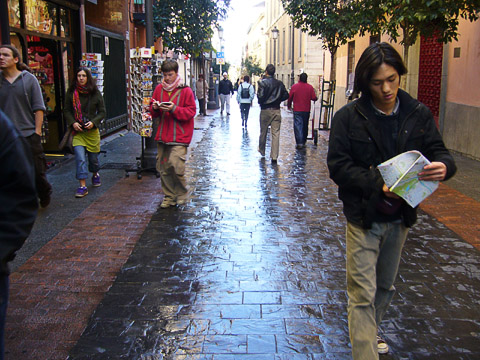 Calle de las Huertas, Madrid ©2007 Mark Fleischmann 10:10Monbiot struck again on 1 September 2009. "We're pumping out CO2 to the point of no return. It's time to alter course." He called on people everywhere to join him in taking the 10:10 pledge: a 10% reduction in personal CO2 emissions by the end of 2010.He begins with the latest science, which seems to hold that there is a ratchet effect with the climate: once temperatures rise, they may not fall again for a very long time. Three 2009 papers sent very bad news. The first showed that the climate change we cause today will be "largely irreversible for 1,000 years after emissions stop." Some 40% of the anthropogenic CO2 produced in this century will remain in the atmosphere in the year 3000. Even if emissions stop completely, global average temperatures are likely to "remain approximately constant . . . until the end of the millennium despite zero further emissions." The other two papers, published by Nature in April, measured the total volume of CO2 we can produce and still avoid more than 2°C of warming. The range given by the two papers lies between 1000 and 1830 gigatonnes of CO2 over the next 500 years. Greenhouse gas release now runs at the rate of 2 gigatonnes a month (CO2 equivalent). One paper suggested that the world can produce only the equivalent of 63 to 75 years of current emissions between now and 2500. The permissible emissions might be used up in as little as 30 years. If only the proven reserves of coal, oil, and natural gas were to be burned, they would release about 3000 gigatonnes of CO2. We must, therefore, not burn more than 60% of these reserves. Prompt and significant cuts are essential. We simply cannot wait. Monbiot says: None of this is on the table. The targets and methodology being used by governments and the United Nations - which will form the basis of their negotiations at Copenhagen - are irrelevant. Unless there is a radical change of plan between now and December, world leaders will not only be discussing the alignment of deckchairs on the Titanic, but disputing whose deckchairs they really are and who is responsible for moving them. Fascinating as this argument may be, it does nothing to alter the course of the liner.Monbiot has taken the pledge. I will, too. Of course, 10:10 must soon become 2015:25 or so, and that's a much tougher challenge. I don't think it can be met without large-scale conversion of existing cities to the carfree model. I'm more than ready to begin.
"We're pumping out CO2 to the point of no return. It's time to alter course" 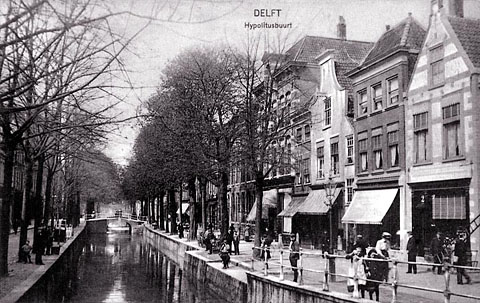 Delft, The Netherlands c. 1900 anon UK EcotownsThe UK government recently gave the go-ahead for four environmentally-friendly ecotowns. The successful bids, which must still go through the planning process, are Rackheath (Norfolk), Whitehill Bordon (East Hampshire), North West Bicester (Oxfordshire) and China Clay (Cornwall).The proposals however, have met opposition from local communities, the Conservative party, and rural protection campaigners. The shortlist of 15 settlements, proposed last year, had already been cut down from 50 applications. There is some debate as to just how green the proposals are. Only Rackheath got a top assessment for sustainability. The benchmarks for an eco-town are:
"Ecotowns given the go-ahead" 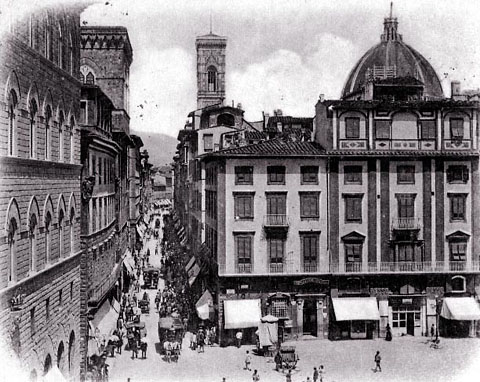 Florence c. 1900 anon Ulrich Franzen's Carfree New YorkWhen I was researching Carfree Cities, I missed an important work. It was a film, not a book. In 1969, architect and urban planner Ulrich Franzen proposed what is basically a carfree vision for Manhattan's Upper East Side, the city's most densely-populated area. Streets were to be reclaimed for human uses. Delivery trucks were to be replaced by dedicated systems, different in arrangement but similar in concept to what I have proposed as "metro-freight." This was a remarkable vision, coming as it did at the very height of the American motor-mania, a time when the bankruptcy of major US automakers was an absurd notion.Franzen envisioned that a two-mile stretch of the east bank of the East River would receive a mega-structure whose function would have been very much the same as the utility areas that I envision. Whether such a huge structure would really have been necessary is a point that can be debated, but the idea of removing utilitarian functions from inhabited areas is sound. The plans included a huge elevated highway running through the utility area and serving its needs. Commuters would have parked there and taken small electric buses, running in new "tube bridges," across the East River to the East Side. Cars were supposed to be given only 10% of land area, and these were all to have been small electric vehicles. The drawings appear to show more room than that being given to them, but large areas of the street would have been freed for human uses. Most of the cross streets would have been closed at mid-block to prevent through traffic. Cafes, playgrounds, trees, and services would have enriched the streets. It is interesting that the film actually shows prototype small electric vehicles zipping around (at speeds that are still too high for an urban area). This was back in the days when the lead-acid cell, then about a century old, was the principal rechargeable battery in use. Their power density is much less than today's batteries, but they had been powering electric vehicles since the turn of the last century. Franzen's plans envisioned virtually no demolition of existing buildings. All that was to be done was to rearrange the streets and get the traffic off them. Electric "mules" would have provided local freight delivery, from the utility area. Vacuum systems would have been used for mail and garbage removal. The web site that displays the film seems to lack a vision of how New York could change in a far more sustainable direction. It is true that some things are not easy to do in Manhattan without a car, but the problem is the lack of an alternative infrastructure. Such projects as the 42nd Street light rail corridor would, if more widely applied, solve most problems getting around Manhattan without a car. Even without these improvements, most New Yorkers accomplish this feat routinely. The site goes on to say, "Only in the last few years has there been a resurgence of the big vision in urban planning and design. Perhaps the new stimulus plan just approved in Washington will provoke - in reaction if not in implementation - a serious reconsideration of our country's thus far inconsistent and uncoordinated approach to infrastructure, energy and transportation." Last month I sent the carfree books off to several policy makers in Washington. So far no response.
"Ulrich Franzen's Street" 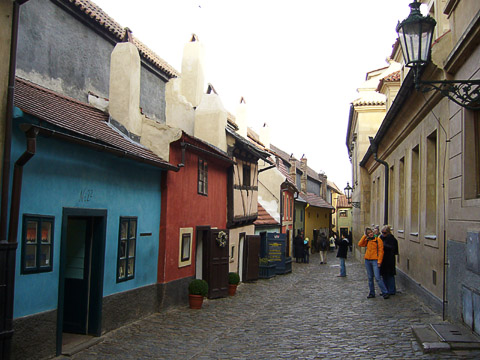 Pedestrianized shopping street near the castle, Prague ©2006 Mark Fleischmann EU Transport "Vision"The European Commission's vision for EU transport policy is a mess. It makes few concessions to climate change concerns."If this is the strategy for fixing rapidly growing pollution, congestion and accidents caused by transport, then we have a big problem. It doesn't even scratch the surface," said Jos Dings, director of the European Federation for Transport and Environment [T&E]. Even the environment directorate was shocked. "It's very much a transport product," the directorate's head of clean air and transport, Philip Owen, said. "We're certainly not a partner on this." Does the left hand know what the right hand is doing? The new document admits that "European transport is still not on a sustainable path in certain aspects." It even recognizes that encouraging leadership in environmental technology will ultimately benefit the European economy. But it only proposes to promote research and investment in provisions for electric and hydrogen-fuelled vehicles. WCN has asked that anyone interested in responding to this disastrous proposal should join them to file a comment by 30 September 2009. The importance of this "vision" is large. It will greatly influence the next ten-year-plan for transport, which will be released early in 2010. Its message is expected to be that "technology will save us." Few proposals regarding demand management and behavior change are expected. The European Automotive Manufacturers Association has said that "spending on road infrastructure has fallen to dangerously low levels" and "improved road infrastructure also offers significant potential for reducing CO2 by enhancing journey efficiency." This needs to be challenged. You can help WCN tell the EC what it should be done to reduce CO2 emissions from transport, along with the attendant secondary benefits this would bring. You can consult the vision document and provisions for making a comment.
"Vision for EU transport future 'a big problem'" 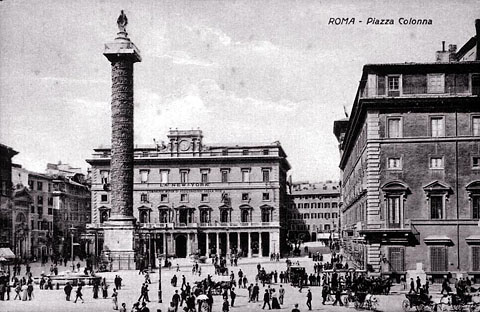 Rome c. 1900 anon Indonesia's traffic nightmareJakarta is a huge city. The population is now estimated at 12 million. Even 20 years ago, when I was last there, traffic was insufferable in this steaming tropical city. Today it's apparently much worse. Pollution levels are extreme and gridlock is routine.Indonesia is a highly class-oriented society. Poor people walk or take the bus. The middle class sits in traffic jams. The rich flit from place to place by helicopter. It's these latter people who make the laws. One new law requires disabled pedestrians to wear traffic signs. These signs in effect say that, in the eyes of the law, cars take priority over people. But this is really how it has always been.
There is an urban rail system, Mass Rapid Transit [MRT], in design, but it won't run before 2016. The number of motor vehicles, including the pervasive motorcycle, has almost tripled in the past eight years to more than nine million. Road space has grown less than 1% annually since 2004. It's not difficult to imagine the resultant traffic congestion. One difficulty for Jakarta is that it is a mostly low-rise city, so the density of construction is not very high. This, however, is counterbalanced by the much lower per-capita space allocation than is typical in the West. Jakarta is ripe for carfree conversion, but it's unlikely that the governing classes will see the need for it or permit it to occur. Jakarta's people will continue to suffer from abysmal air quality for years longer.
"Indonesia's traffic nightmare" 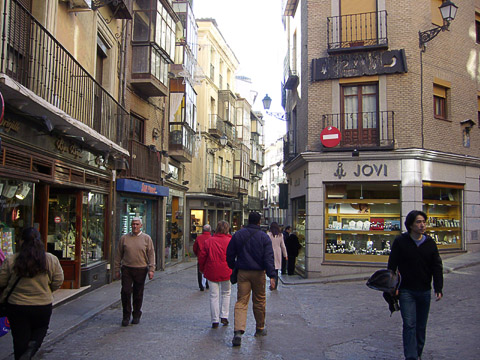 The commercial heart of the old city, Toledo ©2007 Mark Fleischmann Beijing: City of the Future?The situation may be more hopeful in Beijing. Plans have been announced to turn it into a "public transport city" by 2015. At rush hour, subway trains will leave as frequently as every two minutes. Waiting time for buses will be reduced to not more than five minutes. Transport is expected to account for 45% of journeys in downtown. Even the title of the initiative is interesting: "Beijing's implementation plan on humanistic, technological and green transport." It was recently approved by the government.Between 2009 and 2015, Beijing will construct a new transport system comprising four major projects. When complete, public transport will become far more attractive. Rail transit will account for half of all transit passengers. Daily usage will rise to a staggering 25 million trips. Trip times will be reduced, and vehicular pollution reduced to below 2008 levels (and none too soon). The total length of subway in service will reach 561 km. The network will be remarkably fine grained, covering most of the city. Daily passenger flow should exceed 10 million. A Bus Rapid Transit [BRT] system will be built. More than 450 km of bus lanes will be built. They will be connected into a network, with 90% of passengers in downtown areas having to walk less than 500m to reach the nearest bus stop. (This is a quite good standard and compares reasonably well with the 380m standard established in the Reference Design for carfree cities.) Most buses will be air conditioned. Daily passenger flow by bus should exceed 15 million. A major focus has, sensibly, been making transfers as painless as possible. Thirteen transport hubs will be established with a "zero-distance" transfer standard. China, long a huge cycling nation, will see a new commitment to this mode. Cycle lanes will be established, and a sidewalk network for pedestrians will be constructed. More bike parking will be provided. A thousand bike rental stands will be established, although only 50,000 bikes will be offered for rent. Alas, it seems that much of the work is being undertaken to reduce road traffic congestion. Such schemes almost never succeed, and the transit plans will be deemed a failure by many because road traffic will continue to be congested. This is a common logical flaw: if ridership levels of 25 million daily trips are reached, this should be seen as a remarkable achievement in its own right.
"Beijing to build 'public transport city'" 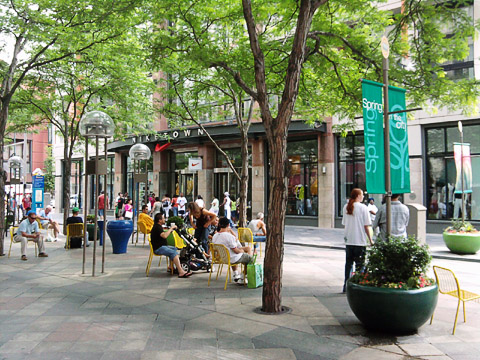 Pearl Street, Denver ©2009 Michael Huston
CNU 17The Congress for the New Urbanism [CNU] recently held its 17th annual congress in Denver. The event, headlined "Experiencing the New Urbanism: the Convenient Remedy," was held from June 10 through the 14th.Notable speakers included the prolific writer James Howard Kunstler and brothers Rob and Leon Krier of Luxembourg, whose renderings of humanly-scaled towns and cities incorporating neo-classical architecture have inspired many an architect and planner (including this one). The program for the Congress offered diverse presentations on such topics as Retrofitting Suburbia, Implementation of Transit Oriented Developments, and the emerging field of Agricultural Urbanism. But, while the CNU advocates for more walkable communities and greater transportation choices, they do not go so far as to promote carfree communities. In fact, when approached about the potential of designing carfree environments, Leon Krier referred to the idea as "utopian," which is ironic given that you would be hard pressed to find a car in one of his idyllic hand-drawn cityscapes. CNU was founded in 1993 by a group of architects who had rediscovered traditional neighborhood planning techniques. The Charter of the New Urbanism, ratified in 1996, is an elegant treatise on the need to control suburban sprawl and build more livable, pedestrian friendly communities. It has advanced the discussion of the destructive forces of our car-centered culture even though, in my opinion, it doesn't quite go far enough.
Special to Carfree Times
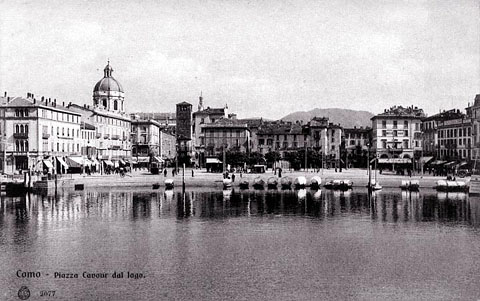 Como c. 1900 anon A Streetcar Named DesirableThe streetcar vs. bus argument has been going on for at least 75 years. It's time to close this argument. The Infrastructurist recently said:For cities facing a choice between building a streetcar system or high-end BRT. . . it's handy to know that transit riders overwhelming prefer streetcars. Well, overwhelmingly if the comments section from a recent story on this site can be taken as a fair sample. One reader posed the question, "buses or streetcars?" and the responses - from lay people and transportation experts alike - came fast and furious. In the end, we were left with dozens of reasons why streetcars are superior, ranging from the obvious to the wonderfully creative.The following 36 points (slightly edited by me) pretty much sum it up:
"36 Reasons Streetcars Are Better Than Buses"
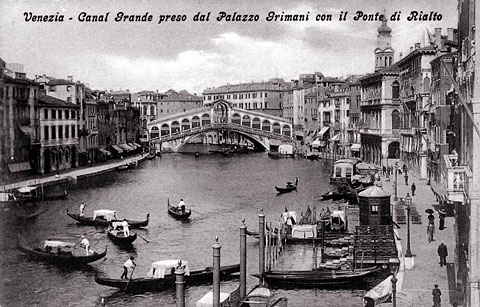 Venice c. 1900 anon Virtual Carfree TourOnce upon a time, in about 1996, there were just a handful of web sites that would be found with the search term "carfree." Today we list the first of "about 2,500,000" results from Google. Even if not a lot is happening on the ground yet, there's plenty happening in people's brains. Real change is at hand.
Carfree.com. You're there.
And so on and on, for millions more. For some strange reason the Carfree_Cities group at Yahoo is not listed in the top sites. It actually has more members than the Carfree group, which is listed. |
Feature Article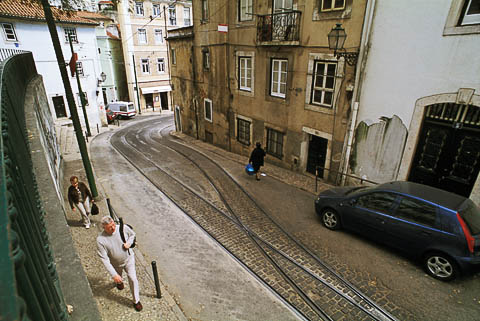
Alfama, Lisbon First Steps in Carfree ConversionsJ.H. CrawfordFirst published in Carbusters #39 (Aug.-Oct. 2009).In the first article (Carbusters #38), we considered the basic principles of carfree conversion as they were established in the Lyon Protocol. We also reviewed the need for a long-term master plan to guide the conversion over a span of decades. This must include an expanded route system for public transport. In this issue we consider why implementation of carfree areas in existing cities must be phased and should proceed at a moderate pace. We also consider measures to reduce car traffic early in the conversion process. Gradual ImplementationAlthough many workers and residents will prefer to walk or cycle to their destinations, almost any carfree conversion demands some form of public transport for a portion of travel within the city. Some people are unable to walk any great distance, or even to move by wheelchair without assistance. Some trips are inconveniently long to cycle, especially in larger cities. And some people, myself included, do not enjoy cycling when the temperature is below freezing. We need frequent, reliable, comfortable service. The means are well known and can be experienced anywhere in Switzerland.
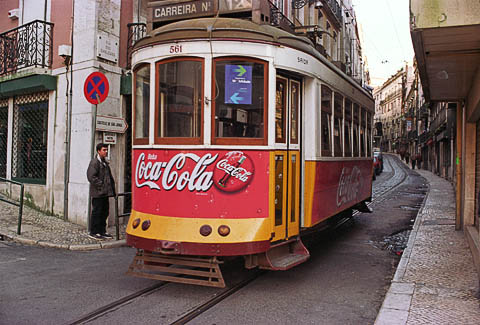
Alfama, Lisbon If we accept the requirement for better public transport as a precondition for carfree conversions, then in most places we will have to wait while public transport is improved. This suggests that conversions should start at locations that are already relatively well served by bus or rail. In the early years, these areas will need car parking at the periphery. As public transport is improved, this need should disappear. The Latin American experience with Bus Rapid Transit [BRT] shows that these systems can be installed in just a few years. I believe BRT masterplans should include long-term plans to replace the buses with trams, as buses are uncomfortable, expensive, noisy, and smelly. In cases where streets are very narrow, small trams can pass where a full-sized bus cannot. This is seen in quite a few places in Lisbon. As an aside, I have for years advocated the development of wireless trams. This would enable new surface-running tram routes to be built as quickly as BRT. All that is necessary is to lay the rails. Almost all new trams are low-floor, so the high-level boarding platforms that BRT requires are not needed. Low-level platforms are quick and cheap to construct. They have the smallest possible impact on the street. At the turn of the last century, tram systems were installed in hundreds of cities nearly overnight. We could do it again, especially if we no longer had to string overhead wires. The aesthetic improvement is considerable, and the cost of maintaining the wires is eliminated. We will also need quick implementation of some zoning changes. An end to single-use zoning as practiced in the USA for the past 70 years is essential. Any use should be permitted at in any location as long as it does not interfere with residential life. This change would reverse the concentration of retailers into a few massive stores located far from where most people live. Families who wanted to open a small retail business in their homes would have a presumptive right to do it. Families should be permitted to move into areas that were once reserved only for offices or stores. In this manner, we can bring goods and services back within walking distance of the places people live and work. This greatly reduces the need for mobility and saves people time. The big-box stores will wither away. As discussed in the last issue, we should think in terms of rings of decreasingly strict limitations on vehicles as we move away from the central carfree areas. Not only will the diameters of these rings be increased over time, new carfree zones will be added as new public transport and cycling infrastructure are completed. It will be nearly impossible to keep trucks out of the carfree area until a rail-based freight delivery system is in place. Dedicated systems will be difficult to install in existing cities, but we can use trams for most freight delivery, a practice that is more than a century old and which is enjoying a small resurgence in Europe. In any case, trucks should be restricted to limited hours, a practice now common in Europe. Load consolidation should be enforced. This eliminates the many nearly-empty trucks entering the city and sends only fully-loaded trucks in their place. The governing principle is that an area can be made carfree as soon as good cycling infrastructure has been built, public transport is not farther than a five-minute walk away, and reasonable arrangements for freight delivery have been made. An important corollary is that the transport route system must permit reasonably easy, quick, and direct service to the important parts of the city. Transfers are the bane of rapid service. They cannot be avoided entirely, but an efficient route network and frequent service help to make them bearable. Incentives to Reduce Car TrafficOne trick that has already been quite widely employed is to make car travel so annoying that it is easier to walk, bike, or take public transport. Cities like Groningen in the Netherlands have divided the city center into several zones. Private cars may not move directly from one zone to the next. They must go all the way out of the city, around the ring road, and back in. Buses, however, move freely between the zones, as do cyclists. Car traffic in the city center is much reduced.In similar fashion, streets can be rearranged so that there are fewer direct routes for cars. Implementation can be as simple as just putting some bollards, tables, and chairs in the middle of a block. This closes the street to through traffic and gives back some important space to local residents without immediately eliminating too much on-street parking (which is likely to give rise to fierce resistance if proposed). A vital measure is the completion of the network of walking and cycling paths, so that direct routes are established to all destinations. In contemporary North American sprawl, destinations that are quite near by require long routes to reach them. This is no problem for car drivers but poses a real obstacle for pedestrians. A few simple paths can solve the problem. More than just these measures is required. I believe that financial disincentives to urban driving should be implemented. These can be put in place without waiting for better public transport, and can be used to pay for it. Externalized costs, such as air pollution and noise, should be monetized and paid by drivers. By some calculations, this will cause the price of fuel to increase by a factor of ten. These changes will considerably disrupt people's lives, so the first increases should be small, with the full charge being implemented over a span of several years. (It has not always been done this way: London's congestion charge in The City started at £5.00.) Parking fees should be increased immediately. Free parking should be eliminated, and all parking should be taxed. Again, rates should start rather low but planned and announced increases should encourage people to begin to change their transport behavior. Experience in Europe shows that people will leave their cars at home if there are strong disincentives to driving and reasonable alternatives. Other disincentives to driving are really incentives to use other modes. We must make the streets more beautiful, quieter, and more lively. We should encourage street food and street entertainment. As street space is reclaimed from cars, we must improve it. This labor-intensive work actually requires relatively little material. We want to remove parking meters, pavement markings, street signs, and the like. They can be replaced by planters, trees, benches and tables, convenient public toilets and drinking fountains, better light-duty pavement, and so forth. We need to fix the storm drains that trap bike wheels and fill the potholes that make riding rough. We will need more bike racks and more public-use bikes. We can reset traffic signals to give shorter greens for cars, which means that pedestrians and cyclists will not be so long delayed. This has the secondary effect of reducing the capacity for car traffic. Intersections should be narrowed and the turning radius sharpened, so cars have to slow down and pedestrians and cyclists have a safer crossing. We will need some car-sharing operations because travel to areas outside the city is not always possible by other modes. Experience has shown that car-sharing schemes encourage people to get rid of their own cars, which helps tremendously with parking. At the same time, the rather high fees for using a car discourage casual use. Finally, I will plead again for what I call the "drag-and-drop bike." This just takes the white-bike program one step farther. The bikes are free for anyone to use. There are no locks, no pin-passes, no electronic release. You just grab the nearest bike and shove it in a rack when you're done. I suppose that kids needing some pocket money will move the bikes to where they are needed and ask for some loose change in return. The bikes themselves can be quite cheap as long as they are simple, single-speed bikes. Pneumatic tires would be replaced by solid ones that never go flat. We will strive to make a delightful environment that encourages people to give up their cars and walk, bike, or take transit. As we do this, the quality of social life on the street will improve dramatically. People will notice the difference and support the ongoing change to a city with ever-fewer cars. One day the last one will be gone. In the next issue, we will take up the need for better, fare-free public transport.
BooksWe have a rich crop of books for this issue. Unfortunately, several of these look so interesting that I will have to read them. I don't have the time now. These capsule reviews will have to suffice for the time being, except for Rick Risemberg's review of The Hidden Dimension.
Fortunately this book is available new or used online, as it is a valuable exploration of the way human beings in different times and cultures interpret and use space, and the effects of both appropriate and inappropriate spatial configurations in urban cultures. In fact, it was author Edward T. Hall's specific intention that the findings examined in this book be applied to urban design. Mr. Hall (who coined the term "proxemics" to describe this field of study) begins with an overview of "distance regulation in animals," to quote one chapter heading, and the effects of crowding and spatial arrangements on social and non-social, territorial and non-territorial animals, collating the findings of numerous studies, including several he managed himself, to do so. He then examines the physiological bases of perception in both animals and humans before moving on to what he calls the "anthropology of space," that is, the different ways humans have devised to arrange, demarcate, and exploit space throughout our history. As he approaches the modern era in his narrative, he deploys specific examples of spatial conventions, mostly derived from his own studies, focusing on US, Northern European, Southern European, Arabic, and Japanese cultures, as well as describing various adaptations and misadaptions of space devised by or imposed upon different subgroupings of US residents, including immigrants and internal immigrants, such as southern blacks who moved north. An example is in the arrangement of rooms, where he contrasts the American practice of lining furniture around the edges of a space with the Japanese preference to group it in the center. Another is in the use of time and schedules, where he recounts the complaints of Northern Europeans that Americans schedule too much into too little time, obviating the possibility of developing or accommodating the relationships that are required to complete the tasks allotted: "Many of my European subjects observed that in Europe human relationships are important whereas in the United States the schedule is important." They also observed that Americans treat space with "incredible casualness. According to European standards, Americans use space in a wasteful way and seldom plan adequately for public needs." This observation exposes the core of one of the great obstacles to making the US social and physical environments both more effective than they presently are, as the demands of a growing population draw down the windfall that the US picked up as it played out the theme of Manifest Destiny. The foundation to many of the problems presented in this book is revealed, of course, as the private automobile, and Mr. Hall devotes several long sections of the latter chapters to the automobile and its normative effect on US culture. Some notable statements: Since the French savor and participate in the city itself...the need for insulating space in the automobile may be somewhat less than it is in the United states where humans are dwarfed by skyscrapers and the products of Detroit [and] visually assaulted by filth and rubbish....These insights, combined with Mr. Hall's detailed explanation of differing cultural interpretations of visual, tactile, auditory, and even olfactory space, and how a knowledge of these differences can be used not only to harmonize but to enrich city life, make this book valuable in itself to any student or proponent of modern urban living. It also stands as a fine complement to important texts such as Alexander's A Pattern Language and Crawford's Carfree Cities.
Reviewed by Rick Risemberg
This is a canonical treatment of the relationship between density and space in cities. I will have to read this book but wanted to put a blurb in Carfree Times now. This is an important work and deserves a full review. From the publisher's blurb: Cities throughout the world are becoming increasingly inefficient in their management of the space available to them. Personal land use is also increasing dramatically; in the Netherlands for instance, this is now twelve times what it was a century ago. And this development is expected to continue worldwide. We must build in higher densities in the cities if the landscape is not to be swallowed up by them. It will mean coaxing people into moving into these compact cities, which will only work if they have an aggregate of cultural and spatial qualities on offer. In his architectural practice and as a professor at Delft University of Technology, Rudy Uytenhaak conducted a study into the densities of the built environment and into ways of offering sufficient spatial compensation for the achieved density. His research led him to formulate a number of specific measures and proposals. Cities Full of Space describes the results of this study and features a great many projects illustrating the quest for ideal plans and sections in residential buildings. Uytenhaak draws on examples from his own work as well as from that of other architects.
From the publisher's web site: We live in an oil-dependent world, arriving at this level of dependency in a very short space of time by treating petroleum as if it were in infinite supply. Most of us avoid thinking about what happens when oil runs out (or becomes prohibitively expensive), but The Transition Handbook shows how the inevitable and profound changes ahead can have a positive outcome. These changes can lead to the rebirth of local communities that will grow more of their own food, generate their own power, and build their own houses using local materials. They can also encourage the development of local currencies to keep money in the local area. There are now over 30 “transition towns” in the UK, Australia and New Zealand with more joining as the idea takes off. They provide valuable experience and lessons-learned for those of us on this side of the Atlantic. With little proactive thinking at the governmental level, communities are taking matters into their own hands and acting locally. If your town is not a transition town, this upbeat guide offers you the tools for starting the process.
This is a revised edition of Architecture: Choice or Fate, a book which I have read and can highly recommend. Krier is, despite his reluctance to say so, one of the few architects who understands pedestrian cities.
The author now works at Lincoln Institute of Land Policy, where I met him this spring. I have not yet had a chance to read this book, and so give the publisher's blurb: Despite a modest revival in city living, Americans are spreading out more than ever - into "exurbs" and "boomburbs" miles from anywhere, in big houses in big subdivisions. We cling to the notion of safer neighborhoods and better schools, but what we get, argues Anthony Flint, is long commutes, crushing gas prices and higher taxes - and a landscape of strip malls and office parks badly in need of a makeover. This Land tells the untold story of development in America - how the landscape is shaped by a furious clash of political, economic and cultural forces. It is the story of burgeoning anti-sprawl movement, a 1960s-style revolution of New Urbanism, smart growth, and green building. And it is the story of landowners fighting back on the basis of property rights, with free-market libertarians, homebuilders, road pavers, financial institutions, and even the lawn-care industry right alongside them. The subdivisions and extra-wide roadways are encroaching into the wetlands of Florida, ranchlands in Texas, and the desert outside Phoenix and Las Vegas. But with up to 120 million more people in the country by 2050, will the spread-out pattern cave in on itself? Could Americans embrace a new approach to development if it made sense for them? A veteran journalist who covered planning, development, and housing for the Boston Globe for sixteen years and a visiting scholar in 2005 at the Harvard Design School, Flint reveals some surprising truths about the future and how we live in This Land.
From the publisher's web site: It is difficult to imagine a world without the car, and yet that is exactly what Dennis and Urry set out to do in this provocative new book. They argue that the days of the car are numbered: powerful forces around the world are undermining the car system and will usher in a new transport system sometime in the next few decades. Specifically, the book examines how several major processes are shaping the future of how we travel, including:
Yet the book also suggests that there are some hugely bleak dilemmas facing the twenty first century. The authors lay out what they consider to be possible "post-car" future scenarios. These they describe as "local sustainability," "regional warlordism" and "digital networks of control." After The Car will be of great interest to planners, policy makers, social scientists, futurologists, those working in industry, as well as general readers. Some have described the 20th Century as the century of the car. Now that century has come to a close - and things are about to change.
From the book's web site: After a lifetime of research and observation, an agonizing decline of the housing market, publication delays and collapse of the stock market, my Cul-de-Sac Syndrome has braved all odds to be published. Why should you care about this book? It's about our homes and communities and how we need to re-invent, re-envision and re-build the American Dream if we want to survive in this contentious century. Economics meets ecology in this radical new look at what we've taken for granted as a birthright. A full review is available at Huffington Post.
Hot New LinksThe links below will open in a new browser window:
Masdar at Pretty Good City The genesis of complex geometry at Emergent Urbanism Demolished! 11 Beautiful Train Stations That Fell To The Wrecking Ball J.H. Crawford on CBC's "Q" radio [MP3!]
About Carfree Times
Next Issue
Subscribe to Carfree Times
Write for Carfree Times
|
| Editor | J.H. Crawford |
| Send e-mail | |
| URL | http://www.carfree.com/
|
Back to Carfree.com
Carfree Times Home
Back to Carfree Times Issue 54
Forward to Carfree Times Issue 56
E-mail
carfree.com
Copyright ©2009 J.Crawford
